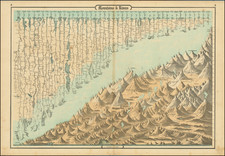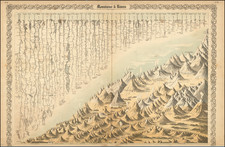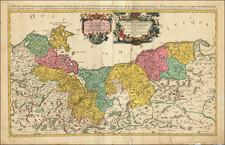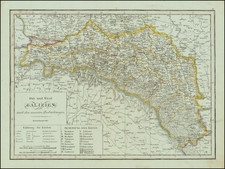Early depiction of the so-called Monster of Cracow, from and early Latin edition of Munster's Cosmography one of the most influential georgaphical works of the 16th Century.
This image is based upon an image by Pierre Boaistua in his Histoires Prodigieuses, published in 1559.
The Monster of Cracow was a deformed child reportedly born in 1543 or 1547 (as reported by Munster) with barking dogs' heads mounted on its elbows, chest and knees. The legend provides that the child depart the world four hours later crying out 'Watch, the Lord Cometh.' This form of allegory was not unusual for Protestant scholars. In 1523 Martin Luther and Philipp Melanchthon published a pamphlet in which they described a deformed 'Monk-Calf' born in Freiburg and another creature, possibly human, that had been fished out of the Tiber, and interpreted both, in vitriolic terms, as symbols of the Roman Church's corruption. Catholics responded by identifying the calf as Luther.
As noted by Wayne Shumaker in The Occult Sciences in the Renaissance . . . (1972) in his translation/interpretation of Boaistua's writings,
A portrait of a monster said to have been born in Cracow in either 1543 or 1547 on the day of St. Paul's conversion. The eyes were fiery, the mouth and nose ox-like; there was a horn like and an elaphant's trunk; th eback was hairy; monkeys heads substituted for teats, there were cat eyes above the navel and dog's heads at the elbows and knees; the hands and feet were a monkey's. Since the monster lived only four hours, the picture must have been drawn from a verbal description. It is wrong, Boaistua says, to think such a monster a devil's child, for devils cannot engender on human beings. The cause is rather divine judgment, a "heated and obstinate imagination of the woman" while she conceives, "subperabundance, or defect and corruption, in the seed," or some other such natural circumstance."
Sebastian Münster (1488-1552) was a cosmographer and professor of Hebrew who taught at Tübingen, Heidelberg, and Basel. He settled in the latter in 1529 and died there, of plague, in 1552. Münster made himself the center of a large network of scholars from whom he obtained geographic descriptions, maps, and directions.
As a young man, Münster joined the Franciscan order, in which he became a priest. He then studied geography at Tübingen, graduating in 1518. He moved to Basel, where he published a Hebrew grammar, one of the first books in Hebrew published in Germany. In 1521 Münster moved again, to Heidelberg, where he continued to publish Hebrew texts and the first German-produced books in Aramaic. After converting to Protestantism in 1529, he took over the chair of Hebrew at Basel, where he published his main Hebrew work, a two-volume Old Testament with a Latin translation.
Münster published his first known map, a map of Germany, in 1525. Three years later, he released a treatise on sundials. In 1540, he published Geographia universalis vetus et nova, an updated edition of Ptolemy’s Geographia. In addition to the Ptolemaic maps, Münster added 21 modern maps. One of Münster’s innovations was to include one map for each continent, a concept that would influence Ortelius and other early atlas makers. The Geographia was reprinted in 1542, 1545, and 1552.
He is best known for his Cosmographia universalis, first published in 1544 and released in at least 35 editions by 1628. It was the first German-language description of the world and contained 471 woodcuts and 26 maps over six volumes. Many of the maps were taken from the Geographia and modified over time. The Cosmographia was widely used in the sixteenth and seventeenth centuries. The text, woodcuts, and maps all influenced geographical thought for generations.










![Повстанцы 1863 Года [(Polish) Insurgents of 1863]](https://storage.googleapis.com/raremaps/img/small/52719.jpg)



